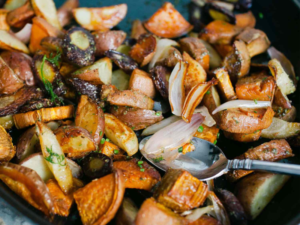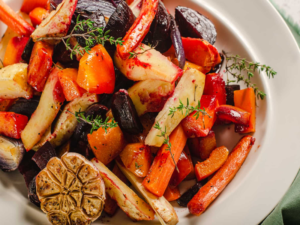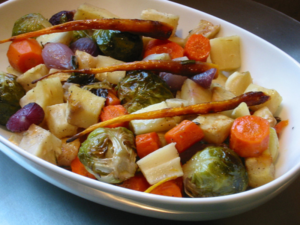
How to Roast Vegetables to Perfection: Your Step-by-Step Guide to Tender, Caramelized Goodness
Are you tired of bland, mushy vegetables? Ready to transform your veggie game from “meh” to marvelous? Roasting is your secret weapon! It’s not just a cooking method; it’s a flavor-unlocking superpower. Imagine tender-crisp textures, intensified sweetness, and that irresistible caramelized color that makes your mouth water.
Roasting isn’t just for gourmet chefs. Whether you’re a busy weeknight warrior or a health-conscious foodie, roasting vegetables is the simplest way to elevate your meals. And the best part? You don’t need fancy skills – just a few basic tips and a willingness to experiment.
By the end of this guide, you’ll be confidently turning out restaurant-worthy roasted vegetables that’ll have everyone asking for your secret recipe. Get ready to discover how easy it is to create vibrant, flavorful dishes that’ll make you fall in love with veggies all over again.

How to Roast Vegetables to Perfection
Why Roasting Vegetables is a Must-Try Technique
If you haven’t explored the world of roasted vegetables yet, you’re missing out on a flavor adventure! Here’s why roasting reigns supreme over other cooking methods:
- Flavor Explosion: Roasting intensifies the natural sweetness of vegetables like carrots, onions, and bell peppers. The high heat caramelizes the sugars, creating a depth of flavor that’s simply irresistible.
- Nutrient Powerhouse: Unlike boiling, which can leach out nutrients, roasting helps to concentrate vitamins and minerals. Plus, it requires minimal added fats, making it a healthy cooking choice.
- Endless Variety: From hearty root vegetables to delicate asparagus spears, almost any vegetable can be transformed by roasting. This versatility means you can enjoy roasted veggies as a simple side dish, the star of a salad, or the base of a flavorful bowl.
- Effortless Cooking: Toss your veggies with oil and seasonings, pop them in the oven, and let the magic happen. With minimal hands-on time, roasting is perfect for busy weeknights or when you’re short on energy.
Ready to see the difference roasting makes? Let’s compare roasted vegetables to their boiled counterparts:
| Vegetable | Roasted | Boiled |
| Carrots | Sweet, caramelized, tender yet slightly crisp | Soft, sometimes mushy, less flavorful |
| Broccoli | Nutty, slightly charred, vibrant green | Dull green, can be watery, less tender |
| Potatoes | Crispy edges, fluffy interior | Can be waterlogged, bland |
Convinced? Let’s move on to choosing the best vegetables for your roasting adventures!
Choosing the Best Vegetables for Roasting – How to Roast Vegetables to Perfection
The beauty of roasting is that it works wonders for a wide variety of vegetables. But some veggies are simply born to be roasted! Here are a few all-star contenders:
- Root Vegetables: Potatoes, sweet potatoes, carrots, parsnips, beets, and turnips all develop a beautiful sweetness and tenderness when roasted.
- Cruciferous Veggies: Broccoli, cauliflower, Brussels sprouts, and cabbage become delightfully crispy and nutty when exposed to high heat.
- Heartier Options: Onions, bell peppers, eggplant, and zucchini all benefit from roasting, developing a rich, smoky flavor and tender texture.
- Winter Squash: Butternut squash, acorn squash, and delicata squash are transformed into creamy, caramelized delights when roasted.
Seasonal Stars:
Don’t forget to embrace the seasons! Use what’s fresh and in season for the most vibrant flavors:
- Spring: Asparagus, green beans, and spring onions
- Summer: Zucchini, tomatoes, corn
- Fall: Brussels sprouts, sweet potatoes, pumpkin
- Winter: Root vegetables, winter squash
Size Matters:
For even roasting, it’s important to cut your vegetables into uniform pieces. This ensures that everything cooks at the same rate and nothing gets overcooked or undercooked. Aim for bite-sized pieces that are roughly the same thickness.
Your Personal Touch:
Ultimately, the best vegetables for roasting are the ones you love! Feel free to experiment and discover your own favorites. You can even combine different vegetables on the same sheet pan for a colorful and flavorful medley.
Ready to gather your tools and dive into the roasting process? Let’s get started!
Essential Tools and Equipment for Roasting Vegetables – How to Roast Vegetables to Perfection
Roasting vegetables doesn’t require a fancy kitchen setup. You most likely already have everything you need! Here is a quick list of the most important things:
- Baking Sheets:Sturdy, rimmed baking sheets are your best friend for roasting. They provide ample space for vegetables to spread out and prevent juices from spilling over. Look for baking sheets made of aluminum or stainless steel for even heat distribution.
- Parchment Paper or Silicone Baking Mats: These handy tools make cleanup a breeze and prevent vegetables from sticking to the baking sheet. If you don’t have either, a light coating of oil on the baking sheet will also work.
- Mixing Bowls: You’ll need a large bowl to toss your vegetables with oil and seasonings. A smaller bowl can be helpful for whisking together any sauces or marinades.
- Cutting Board and Sharp Knife: A good cutting board and sharp knife are essential for prepping your vegetables. Make sure your knife is sharp enough to easily cut through vegetables without crushing them.
Optional but Helpful Tools:
- Tongs: These are great for flipping vegetables halfway through roasting.
- Instant-Read Thermometer: While not strictly necessary, an instant-read thermometer can help you ensure that your vegetables are cooked to perfection.
With these tools in hand, you’re ready to take on the roasting process! Now let’s get to the step-by-step guide.
Mastering the Roasting Process: A Step-by-Step Guide
Ready to roast your veggies to perfection? Follow these simple steps for tender, caramelized results every time:
Step 1: Preheat the Oven
The ideal roasting temperature for most vegetables is between 400°F and 450°F (200°C and 230°C). This high heat helps to caramelize the sugars and create that desirable crispy exterior. Make sure your oven is fully preheated before you put your vegetables in.
Step 2: Prepare the Vegetables
- Wash and dry: Thoroughly wash your vegetables under cool running water and pat them dry with a clean kitchen towel.
- Cut into uniform pieces: Aim for bite-sized pieces that are roughly the same size and thickness. This ensures even cooking.
- Remove excess moisture: If you’re roasting vegetables with a high water content (like zucchini or mushrooms), consider salting them lightly and letting them sit for 15-20 minutes. This will draw out excess moisture and help them roast instead of steam.
Step 3: Toss in Oil and Seasonings
- Oil: Drizzle your vegetables with olive oil or another high-heat oil like avocado oil. Use enough oil to lightly coat the vegetables, but not so much that they’re swimming in it.
- Seasonings: Salt and pepper are a must, but don’t stop there! Use your favorite spices and herbs in new ways. Now let’s get to the step-by-step guide. Here are a few ideas:
- Garlic powder
- Onion powder
- Paprika
- Cumin
- Chili powder
- Dried oregano
- Dried thyme
- Rosemary
- Fresh herbs (chopped)
Step 4: Arrange in a Single Layer
Spread your vegetables out in a single layer on your prepared baking sheet. If there are too many people in the oven, it might steam instead of cook. If necessary, use two baking sheets.
Step 5: Roast!
Place your baking sheet in the preheated oven. Roasting times will vary depending on the type of vegetable and the size of the pieces. Here’s a general guideline:
| Vegetable | Roasting Time (approximate) |
| Asparagus | 10-15 minutes |
| Broccoli florets | 20-25 minutes |
| Brussels sprouts | 30-40 minutes |
| Carrots | 25-35 minutes |
| Cauliflower florets | 25-35 minutes |
| Onions | 35-45 minutes |
| Potatoes | 30-45 minutes |
| Sweet potatoes | 40-50 minutes |
Remember, these are just guidelines. The best way to determine if your vegetables are done is to check them visually and with a fork. They should be tender and easily pierced with a fork, with some browning on the edges.
Bonus Tip: For extra crispy edges, flip the vegetables halfway through roasting.
Now that you’ve mastered the basics, let’s explore some flavor combinations to take your roasted vegetables to the next level!

How to Roast Vegetables to Perfection
Flavor Combinations to Elevate Your Roasted Vegetables – How to Roast Vegetables to Perfection
While roasted vegetables are delicious on their own, adding a few well-chosen seasonings can take them from simple to sensational. Here are some flavor combinations that will make your taste buds sing:
Classic Pairings:
- Garlic and Herbs: Garlic powder, onion powder, dried oregano, and dried thyme are a classic combination that complements many vegetables.
- Balsamic Vinegar and Honey: The tangy sweetness of balsamic vinegar pairs beautifully with the earthy sweetness of honey. Drizzle this mixture over your roasted vegetables in the last few minutes of cooking.
- Lemon and Thyme: The bright acidity of lemon juice or zest, combined with the herbaceous aroma of thyme, creates a refreshing and flavorful combination.
Spice It Up:
- Curry Powder: A blend of warming spices like turmeric, cumin, and coriander, curry powder adds depth and complexity to roasted vegetables.
- Smoked Paprika: Smoked paprika adds a smoky, slightly sweet flavor that’s perfect for root vegetables like potatoes and sweet potatoes.
- Cumin and Chili Powder: This duo delivers a warm, earthy flavor with a hint of heat.
Sweet and Savory:
- Maple Syrup: A drizzle of maple syrup adds a touch of sweetness and complements the natural flavors of root vegetables like carrots and parsnips.
- Brown Sugar: Sprinkle a little brown sugar over your vegetables in the last few minutes of roasting to create a caramelized crust.
- Balsamic Glaze: Reduce balsamic vinegar over low heat until it thickens into a syrupy glaze. Drizzle over roasted vegetables for a tangy, sweet, and savory flavor explosion.
Global Inspiration:
- Mediterranean: Toss vegetables with olive oil, oregano, thyme, garlic, and lemon juice.
- Mexican: Combine cumin, chili powder, smoked paprika, garlic powder, and a pinch of cayenne pepper.
- Indian: Use curry powder, turmeric, cumin, coriander, and garam masala.
Pro Tip: Don’t be afraid to experiment! Mix and match different herbs, spices, and other seasonings to create your own signature flavor combinations.
Let’s move on to troubleshooting some common roasting challenges!
Troubleshooting Common Roasting Challenges – How to Roast Vegetables to Perfection
Even seasoned home cooks can run into a few hiccups when roasting vegetables. To fix the most usual problems, follow these steps:
Burnt Edges:
- Lower the Oven Temperature: If your vegetables are consistently burning around the edges, try lowering the oven temperature by 25°F (15°C).
- Use a Larger Baking Sheet: Overcrowding can lead to uneven cooking and burnt edges. Make sure your vegetables have enough space to spread out on the baking sheet.
- Add a Splash of Water: If your vegetables are starting to burn, add a splash of water or broth to the baking sheet. This will create steam, which can help to prevent further burning.
Soggy Vegetables:
- Ensure Vegetables are Dry: Pat your vegetables dry with a clean kitchen towel before tossing them in oil and seasonings. If there is too much wetness, the food may steam instead of cook.
- Avoid Overcrowding: Make sure your vegetables have enough space to spread out on the baking sheet. Overcrowding prevents air from circulating, which can result in soggy vegetables.
- Roast in Batches: If you’re roasting a large quantity of vegetables, it’s better to roast them in batches rather than overcrowd the baking sheet.
Uneven Cooking:
- Cut Vegetables into Uniform Sizes: Aim for pieces that are roughly the same size and thickness. This keeps everything cooking at the same speed.
- Stir Halfway Through Roasting: Give your vegetables a good stir halfway through the cooking time to ensure even browning.
Other Tips:
- Don’t Over-Oil: While a little oil is necessary for roasting, too much can make your vegetables greasy. There’s no need for a thick coat.
- Preheat the Baking Sheet: For extra crispy vegetables, preheat your baking sheet in the oven along with the oven itself.
- Use High-Quality Oil: Choose an oil with a high smoke point, such as olive oil or avocado oil. This prevents the oil from burning and imparting an unpleasant flavor to your vegetables.
With these troubleshooting tips in your arsenal, you’re well on your way to becoming a roasting pro! Let’s move on to storing and reheating your delicious creations.
Storing and Reheating Roasted Vegetables – How to Roast Vegetables to Perfection
Roasted vegetables are a versatile dish that can be enjoyed hot out of the oven or later as part of a meal prep strategy. Here’s how to store and reheat your roasted veggies to maintain their flavor and texture:
Refrigerating Roasted Vegetables
- Cool completely: Allow your roasted vegetables to cool completely before storing them. This helps to prevent condensation, which can lead to soggy vegetables.
- Airtight container: Transfer the cooled vegetables to an airtight container. This helps to maintain freshness and prevent the vegetables from absorbing odors from other foods in your refrigerator.
- Storage time: Roasted vegetables can be stored in the refrigerator for 3-4 days.
Freezing Roasted Vegetables
If you want to extend the life of your roasted vegetables even further, you can freeze them. Here’s how:
- Cool and portion: Cool the roasted vegetables completely and divide them into individual portions. You can thaw only what you need this way.
- Freezer-safe bags: Place the portions in freezer-safe bags, squeezing out as much air as possible before sealing.
- Label and date: Label the bags with the contents and date, and freeze for up to 2-3 months.
- Thawing and reheating: Thaw frozen vegetables in the refrigerator overnight. Heat it again in the oven or on the stove until it’s hot all the way through.
Reheating Roasted Vegetables
- Oven: Preheat your oven to 350°F (175°C). Place the veggies on a baking sheet in a single layer. Bake for 10 to 15 minutes, or until the vegetables are warm all the way through.
- Stovetop: Heat a skillet over medium heat. Add a little oil and then add the roasted vegetables. Cook, stirring occasionally, until heated through.
- Microwave: While not the most ideal method, you can reheat roasted vegetables in the microwave. Place the vegetables in a microwave-safe dish, cover with a damp paper towel, and heat in short intervals until heated through.
Pro Tip: Reheating in the oven or on the stovetop will help to restore some of the crispness that may have been lost during storage.
Now that you know how to store and reheat your roasted vegetables, you can enjoy them anytime! Let’s end with a few short ideas.

How to Roast Vegetables to Perfection
Embrace the Magic of Roasted Vegetables – How to Roast Vegetables to Perfection
Congratulations! You’ve now unlocked the secrets to roasting vegetables to perfection. It’s time to unleash your creativity in the kitchen and transform ordinary vegetables into extraordinary culinary creations. Remember, roasting is not just a cooking method, it’s a journey of flavor exploration.
As you embark on your roasting adventures, keep these key takeaways in mind:
- Flavor First: Choose vegetables that you love and experiment with different seasoning combinations to discover your favorites.
- Don’t Overcrowd: Give your vegetables enough space on the baking sheet to ensure even cooking and crispy edges.
- Check for Doneness: Use visual cues and a fork to test for tenderness and doneness.
- Store and Reheat Properly: Follow the guidelines for storing and reheating to maintain the flavor and texture of your roasted vegetables.
Now it’s your turn to shine! Share your roasted vegetable creations with the world, try out new recipes, and don’t hesitate to ask questions along the way. Remember, the most important ingredient in any dish is your passion for cooking. Happy roasting!
Call to Action:
- Share your favorite roasted vegetable recipes in the comments below.
- Show off your culinary masterpieces on social media using the hashtag #RoastedVeggies.
- Tag me in your posts, because I want to see what you’ve made!
Please let me know if you need anything else.
I hope you found this blog post helpful! Let me know if you have any other questions.
